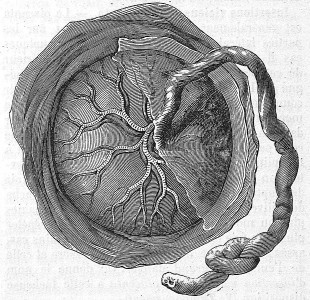
 Fig. 1074: Placenta (internal or foetal side). Paul Labarthe, Dictionnaire populaire de médecine usuelle, vol. 2, 1887, p. 749.
Fig. 1074: Placenta (internal or foetal side). Paul Labarthe, Dictionnaire populaire de médecine usuelle, vol. 2, 1887, p. 749.
The placenta is an organ that connects physically and biologically the infant to its mother. During the pregnancy, it is essential to the fetus’ survival because it provides water, nutrients, and oxygen. It also gets rid of the waste produced by the fetus as carbon dioxide. Moreover, the placenta has an immune function. It acts as a barrier between the fetus and the environment and only lets through the mother’s antibodies to build up the fetus’ immunity. Lastly, it produces hormones that help maintain the pregnancy and prepare the mother’s body for delivery and breastfeeding.
These are all the roles that make this organ special.
Across centuries and cultures, the placenta was at the centre of various beliefs and practices. In France, until the mid-20th century, particularly in the countryside, women did not give birth in hospitals. The fate of the placenta was, then, tied to beliefs about childbirth.
During the modern period, the latter was considered the symbolic twin of the fetus. It was buried by the father, who then planted a tree on that site. Way before the medicalisation of childbirth, the placenta was already at the centre of strong beliefs.
However, from the middle of the 20th century, many women gave birth at hospitals. It contributed to creating a new birth arrangement and changing the relationship between the mother and her infant.
The parturient who used to give birth in her home, surrounded by women of her community, now gives birth in a medical environment where decisions are made about her body. This context brought new practices and a new conception of the placenta. It had a bad image because it was associated with blood, particularly menstrual blood, and sexuality.
Since the 1960s, due to diseases such as hepatitis B, C and HIV, the placenta was considered a high-risk “waste”. To this day, the placenta is sent to the crematorium because of its status of “surgical waste”. According to the law of 29 July on the respect of the human body, no authorisation is therefore required for its use. For example, it could be sold without the mother’s permission.
In fact, recent medical discoveries showed the therapeutic benefits of this organ, and since the 80s, the placenta has a better image. The placenta has sometimes been sold to pharmaceutical companies without the mother’s consent.
For all these reasons, the placenta is taken from the mother without her agreement.
Since the 1960s-1970s, a need to return to nature manifested through women’s childbirth. The placenta’s status changes. From a biological waste to a crucial element due to its therapeutic benefits. An increasing number of women want to keep their placenta to take it in various forms, most of the time as a powder or capsules. The symbolism around the placenta got stronger. For example, it represents the bond between the mother and child. It has a central role in the parent-child relationship and helps to build its identity as a mother or a child. Yet the placenta is a simple piece of flesh, but all the beliefs around it raise it to a symbolic object.
However, despite these new expectations, the placenta is removed afterbirth, without the mother’s consent. Medical staff don’t consider this new approach to the placenta nor the patient’s will. To counter this, reforms are implemented toward patients’ wishes about their bodies.
On 9 July, the article of the Public Health Code (Code la Santé) that provided for the status of the placenta was amended. It is no longer considered a waste, and the medical staff has to wait for the patient’s authorisation before using it. It includes the “obligation to offer” all possibilities to patients. Therefore, it shows a better understanding of the mothers' and patients’ will. Nowadays, the human body is not considered simply as flesh, but as a part of the patient’s identity. The medical staff has to adapt to this new dimension.
Read more in the dictionary: Hymen - Caesarian section - Clitoris
Read the paper in French : Placenta
References :
Dominique Memmi, La revanche de la chair. Essai sur les nouveaux supports de l'identité, Seuil, Isle-d'Espagnac, 2014.
Daphné Meyer, "Le placenta des uns et des autres", Diplôme d'Etat de sage-femme, Université de Nantes, 2012.
To quote this paper : Mathilde Bourand, “Placenta”, in Hervé Guillemain (ed.), DicoPolHiS, Le Mans Université, 2023.